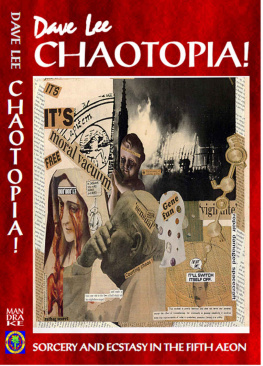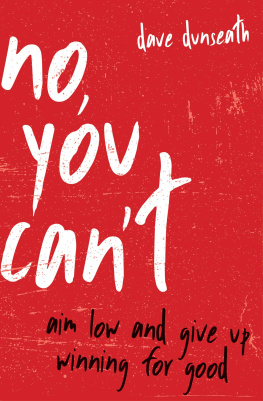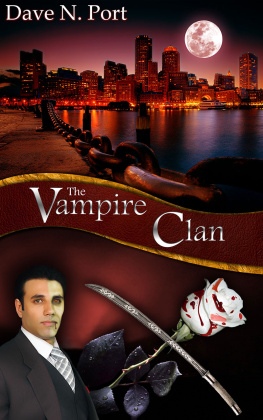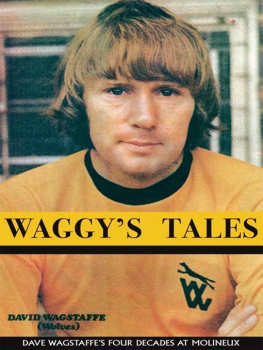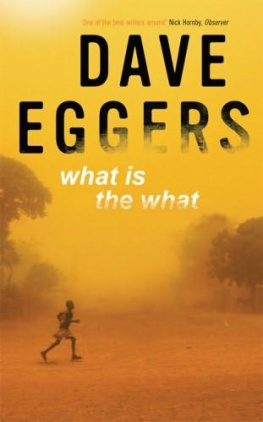Dave Lee - Chaotopia!
Here you can read online Dave Lee - Chaotopia! full text of the book (entire story) in english for free. Download pdf and epub, get meaning, cover and reviews about this ebook. year: 2019, publisher: Mandrake, genre: Religion. Description of the work, (preface) as well as reviews are available. Best literature library LitArk.com created for fans of good reading and offers a wide selection of genres:
Romance novel
Science fiction
Adventure
Detective
Science
History
Home and family
Prose
Art
Politics
Computer
Non-fiction
Religion
Business
Children
Humor
Choose a favorite category and find really read worthwhile books. Enjoy immersion in the world of imagination, feel the emotions of the characters or learn something new for yourself, make an fascinating discovery.
Chaotopia!: summary, description and annotation
We offer to read an annotation, description, summary or preface (depends on what the author of the book "Chaotopia!" wrote himself). If you haven't found the necessary information about the book — write in the comments, we will try to find it.
Chaotopia! — read online for free the complete book (whole text) full work
Below is the text of the book, divided by pages. System saving the place of the last page read, allows you to conveniently read the book "Chaotopia!" online for free, without having to search again every time where you left off. Put a bookmark, and you can go to the page where you finished reading at any time.
Font size:
Interval:
Bookmark:
Table of Contents
CHAOTOPIA!
SORCERY AND ECSTASY IN THE FIFTH AEON
BY
DAVE LEE

Copyright 2006 Mandrake & Dave Lee
First published 1997 by Attractor
All graphics and collages Copyright David Lee.
All rights reserved. No part of this work may be reproduced or utilized in any form by any means electronic or mechanical, including xerography, photocopying, microfilm , and recording, or by any information storage system without permission in writing from the publishers.
With thanks to Hannibal The Cannibal for collaboration on the Exorcism material, Phil Hine, and the IOT's Pandaemonaeon Conclave.
Published by
Mandrake of Oxford
PO Box 250
OXFORD
OX1 1AP (UK)
A CIP catalogue record for this book is available from the British Library and the US Library of Congress.
1869928881
CHAOTOPIA!
FOREWORD TO THIS EDITION
I finished writing Chaotopia! in October 1997, published it, and then, in half the time I'd allowed for, sold out of copies.
I moved on to other projects, writing and otherwise and, when I picked the book up again with an eye to republishing it, had the gratifying experience of disagreeing with myself over some of its content. So I started to rewrite it, in the hope of producing a more definitive picture of what I've learned from my years of magical experience. But of course the picture is still moving, and the rewrite would have turned out to be another snapshot along the way.
So I decided to content myself with rewriting the introduction, adding some new material and a Glossary of Chao-Speak, because it was requested by readers who didn't want to work through an entire reading list to find out what Chaos Magicians are on about. Who says books on Chaos Magic aren't user-friendly?
The core idea of Pete Carroll's Liber Null was to model what actually works in practical sorcery. The core idea of Chaotopia! was to extend that `whatever works' approach to the techniques of ecstasy and the still-wooly realms of mysticism, and to see what can be learned from the connections between them. That project continues.
Dave Lee, London 2004
INTRODUCTION
CHAOS MAGIC :
THE STORY SO FAR
In 1978 the first edition of Pete Carroll's book Liber Null appeared. This laid the groundwork for what was later to
be called Chaos magic(k). Inspired by the individualistic approach of English artist and magician Austin Osman Spare, Carroll took apart various magical systems and constructed his own minimalist model of how magic can be made to work. He identifies two core principles of successful magic:
1. Gnosis : which means in this context an altered state of consciousness. Gnosis is achieved through excitation to the point of mental saturation via dancing, drumming, sex etc, or through inhibition of the normal mental/emotional functions through prolonged meditation, stillness, breath control etc. The result in both cases is (hopefully) a brief cessation of the internal monologue and a focussing of the powers of consciousness onto a single aim or symbol.
2. Belief as a technique : we take on a belief in order to achieve a particular effect on our circumstances or ourselves. The belief is considered "true" only for the time we employ it; a belief becomes a tool of magical transformation and sorcery, rather than the envelope of "truth" inside which the magical practice is performed. This is signified in the slogan Nothing is True, Everything is Permitted .
These principles show that Chaos magic is not a system, but a way of looking at systems of magic and extracting from them the parts that really work for the individual magician. Obviously, this approach to magic didn't start with Liber Null , but Carroll's early work brought this approach into focus for many people, people who had wanted to do magic that actually works in a real and tangible way, but were lost in the usual morass of obscurantism, pretension and endlessly-rehashed renaissance texts.
The Chaos magician strives for excellence in magical skills, and regards a tangible result as proof that the magic has worked, in contrast to the credulous consumer of new age workshops, who would probably be scared away if any real result followed his `shamanism'. Many Chaos magicians have tended to define a `real' result as some physical, objective change in the magician's world. Whilst this is obviously not the only form of magical result, it is certainly ample proof that something unusual is happening, and Chaos Magic texts have concentrated on this aspect of magic _ `results magic' or sorcery.
Once one is fairly competent at practical sorcery, there is little of importance that remains to be said or read about the subject; the magician at this point tends to emphasize inner development in his work. It seems to me that Chaos Magic itself has reached this point; the basic ideas needed for anyone to construct his or her own system of sorcery and to hone their skills are already covered by the available books. What has been lacking so far, is a Chaos magical approach to the investigation of the ecstatic states that underlie magical gnosis. This book, rather than trying to provide yet another slightly different flavour of Chaos technique, takes as its starting point the relationship between ecstasy and magic; between Chaos Magic and Chaos Mysticism, if you like.
CARVING UP THE BEAST
The above considerations gave me the book's title. Chaotopia is neither Utopia nor its opposite: it is what Austin Spare called `the chaos of the normal', seen through an illuminated eye, the eye of the sorcerer. Various obsessional themes run through the chapters: principles of evolution; consciousness models; Body Alchemy ; ecstasy; Aeonics . These themes are distributed through most of the book, culminating in the final chapters.
The chapters on Sex, Conflict and Money are technical updates, not exhaustive manuals. Themes in these areas don't change much; after all, these are three of the four stereotypical reasons why people are attracted to magic in the first place, so their inclusion is not in any way controversial. The fourth is Healing, which is dealt with under the rather more complex topic of Body Alchemy. Nobody in Chaos Magic argues much about these areas. All the arguments are about Illumination, Aeonics and other abstract themes.
The other chapters deal with the more contentious topics, approaching them from various novel angles, taking slices through the Beast that is Magic. The question I ask when I come across a theory is: What use can I get out of this?
Magic is like a multidimensional entity, a concept so large that it touches everything. And, by its very nature, most of it is hidden, in the domain of the mystery, eternally pursued by the questing mind. There is no absolutely satisfactory system or model of magic; at best, a book on magic is an evaluation of technique wrapped around a believable model. We all cut through the beast at an angle decided by our obsessions, and that is exactly what I shall be doing.

Magic is a delicate art, with a low success-rate, at least initially. The motivation for it is non-ordinary; generally, if I could do something without magic, I would. Magic stretches your boundaries, gives a sense and an intelligence to life, allows the development of purpose.
We choose our worlds all the time; we affirm or deny some `fact' or other many times a day. A magician is careful how she does this: it is precisely how we hold together our reality. Consciously or not, we are always choosing beliefs. We tell ourselves stories about who we are and what the world is in relation to us.
Next pageFont size:
Interval:
Bookmark:
Similar books «Chaotopia!»
Look at similar books to Chaotopia!. We have selected literature similar in name and meaning in the hope of providing readers with more options to find new, interesting, not yet read works.
Discussion, reviews of the book Chaotopia! and just readers' own opinions. Leave your comments, write what you think about the work, its meaning or the main characters. Specify what exactly you liked and what you didn't like, and why you think so.

